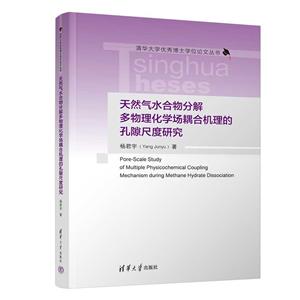-
>
湖南省志(1978-2002)?铁路志
-
>
公路车宝典(ZINN的公路车维修与保养秘籍)
-
>
晶体管电路设计(下)
-
>
基于个性化设计策略的智能交通系统关键技术
-
>
德国克虏伯与晚清火:贸易与仿制模式下的技术转移
-
>
花样百出:贵州少数民族图案填色
-
>
识木:全球220种木材图鉴
天然气水合物分解多物理化学场耦合机理的孔隙尺度研究 版权信息
- ISBN:9787302662488
- 条形码:9787302662488 ; 978-7-302-66248-8
- 装帧:精装
- 册数:暂无
- 重量:暂无
- 所属分类:>
天然气水合物分解多物理化学场耦合机理的孔隙尺度研究 本书特色
《天然气水合物分解多物理化学场耦合机理的孔隙尺度研究》利用孔隙尺度数值模拟,分析了天然气水合物分解过程多物理化学场控制机制,从热质传递角度揭示了影响天然气水合物分解速率的控制因素,改进了天然气水合物生产预测的经验模型,推动了水合物分解过程的尺度升级研究,有助于实现天然气水合物高效开发。
天然气水合物分解多物理化学场耦合机理的孔隙尺度研究 内容简介
天然气水合物资源在全球分布广泛、储量丰富,是具有前景的清洁能源。然而目前天然气水合物开采仍面临生产效率低下等技术难题,至今未能实现大规模商业开发。由于天然气水合物分解是多孔介质中复杂的多物理化学问题,从孔隙尺度出发认识水合物分解控制机制,对指导水合物高效开采具有重要意义。《天然气水合物分解多物理化学场耦合机理的孔隙尺度研究》针对天然气水合物分解过程,开展了孔隙尺度研究,分析了水合物分解过程多物理化学场控制机制,推动了水合物分解过程的尺度升级研究,为实现天然气水合物高效开发提供了理论基础。 《天然气水合物分解多物理化学场耦合机理的孔隙尺度研究》立足水合物分解过程中的热质传递规律这一科学问题,聚焦水合物开采前沿技术领域,适合从事能源工程、油藏工程等相关领域的读者阅读。
天然气水合物分解多物理化学场耦合机理的孔隙尺度研究 目录
1.1研究背景及意义
1.2研究现状及分析
1.2.1天然气水合物分解控制机制研究现状
1.2.2天然气水合物生产预测模型研究现状
1.2.3孔隙尺度多场耦合问题数值方法研究现状
1.3研究内容及方法 第2章多场耦合格子玻尔兹曼方法的建立与验证
2.1引论
2.2天然气水合物分解过程涉及的多物理问题及控制方程
2.3基于格子玻尔兹曼方法的多场耦合数值模型
2.3.1多组分多相伪势模型
2.3.2跨相传质模型及非均相反应边界处理
2.3.3共轭传热模型
2.3.4固相演化模型
2.3.5多场耦合数值计算流程
2.4多场耦合数值模型的验证
2.4.1热力学一致性验证及杨拉普拉斯实验
2.4.2多相泊肃叶流动数值模拟
2.4.3方腔内反应传质过程计算
2.4.4封闭区域内的CO2溶解过程计算
2.4.5Rayleigh-Bernard自然对流计算
2.5本章小结 第3章天然气水合物分解过程传热传质控制机理分析
3.1引论
3.2物理模型及计算参数
3.3计算结果及讨论
3.3.1水合物分解控制机理分析
3.3.2孔隙尺度水合物分解实验的数值模拟研究
3.3.3考虑传质限制作用的修正反应动力学模型
3.4本章小结 第4章跨相传质CST-LB模型的建立与验证
4.1引论
4.2跨相传质CST-LB数值模型
4.3CST-LB模型的验证
4.3.1相界面处的浓度阶跃数值模拟
4.3.2封闭区域内气体溶解数值模拟
4.3.3毛细管驱替过程组分输运数值模拟
4.3.4多孔介质多相传质问题数值模拟
4.4非均相反应边界格式及改进的润湿边界格式
4.4.1CST-LB非均相反应边界处理格式
4.4.2多组分伪势模型润湿性边界格式的改进
4.5多相体系中非均相反应数值模拟的比较研究
4.5.1三种伪势模型润湿性边界格式的比较
4.5.2考虑非均相反应的一维多相传质问题
4.5.3有液滴覆盖的圆柱体溶解问题
4.5.4毛细管驱替过程的反应传质问题
4.5.5多孔介质中的多相溶解问题
4.6本章小结 第5章天然气水合物在气水运移过程中的分解规律研究
5.1引论
5.2物理问题及数值模型
5.3计算结果及讨论
5.3.1纯单相流动工况下水合物分解模式及控制机制
5.3.2多相流动工况下水合物分解模式及控制机制
5.3.3考虑气水运移影响的水合物分解模式图
5.3.4考虑分解模式的渗流模型及水合物表面积模型
5.4本章小结 第6章结论与展望
6.1结论
6.2本书的创新点
6.3研究展望 参考文献 致谢 Contents Chapter 1Introduction
1.1Research background
1.2Current state of research
1.2.1Methane hydrate controlling mechanisms
1.2.2Methane hydrate production prediction models
1.2.3Numerical methods for multiple physicochemical coupling problems at the pore scale
1.3Research content and methods Chapter 2Establishment and Verification of Lattice Boltzmann Method for Multiple Physicochemical Coupling Problems
2.1Introduction of this chapter
2.2Physical problems and governing equations involved in the methane hydrate dissociation process
2.3Multiple physicochemical numerical models based on the lattice Boltzmann method
2.3.1Multi-component multiphase pseudopotential model
2.3.2Interfacial mass transfer model and heterogeneous reaction boundary treatment
2.3.3Conjugate heat transfer model
2.3.4Solid evolution model
2.3.5Numerical implementation
2.4Verification of the numerical models
2.4.1Thermodynamic consistency and Young-Laplace test
2.4.2Multiphase Poiseuille flow
2.4.3Reactive mass transfer in a square cavity
2.4.4CO2 dissolution in a closed system
2.4.5Rayleigh-Bernard natural convection
2.5Summary of this chapter Chapter 3Analysis of Heat and Mass Transfer Mechanisms during the Methane Hydrate Dissociation Process
3.1Introduction of this chapter
3.2Physical problems and numerical parameters
3.3Numerical results and discussion
3.3.1Controlling mechanisms of methane hydrate dissociation
3.3.2Numerical simulation of dissociation experiments
3.3.3Kinetics model considering the mass transfer limitation
3.4Summary of this chapter Chapter 4Establishment and Verification of CST-LB Model for the Interfacial Mass Transfer
4.1Introduction of this chapter
4.2CST-LB model for the interfacial mass transfer
4.3Verification of the CST-LB model
4.3.1Concentration jump at the phase interface
4.3.2Gas dissolution in a closed system
4.3.3Reactive transport during drainage in a capillary tube
4.3.4Multiphase reactive transport in the porous media
4.4Heterogeneous reaction boundary treatment and improved wetting boundary scheme
4.4.1Heterogeneous reaction boundary for CST-LB model
4.4.2Improvement of wetting boundary treatment for Multi-component pseudopotential model 4.5Comparative study of multiphase reactive transport numerical simulations
4.5.1Comparison of wetting boundary treatments
4.5.2One-dimensional multiphase mass transfer with heterogeneous chemical reaction
4.5.3Cylinder dissolution covered with a droplet
4.5.4Reactive transport in capillary displacement process
4.5.5Multiphase dissolution process in the porous media
4.6Summary of this chapter Chapter 5Investigation on the Methane Hydrate Dissociation Dynamics Considering Gas-Water Migration
5.1Introduction of this chapter
5.2Physical problems and numerical models
5.3Numerical results and discussion
5.3.1Methane hydrate dissociation mechanisms under Single-phase flow conditions
5.3.2Methane hydrate dissociation mechanisms under multiphase flow conditions
5.3.3Methane hydrate dissociation regime diagram considering the gas-water migration
5.3.4Permeability model and hydrate surface area model
5.4Summary of this chapter Chapter 6Conclusions and Perspectives
6.1Conclusions
6.2Innovation points of this book
6.3Perspectives References Acknowledgements
天然气水合物分解多物理化学场耦合机理的孔隙尺度研究 作者简介
杨君宇,2013年9月考入清华大学热能工程系,2017年7月本科毕业并获得工学学士学位;2017年9月免试进入清华大学能源与动力工程系攻读动力工程及工程热物理专业,师从史琳教授,2022年7月获得工学博士学位;2022年9月至今于英国伦敦大学学院机械工程系从事研究工作。
- >
有舍有得是人生
有舍有得是人生
¥17.1¥45.0 - >
随园食单
随园食单
¥15.4¥48.0 - >
朝闻道
朝闻道
¥8.8¥23.8 - >
我从未如此眷恋人间
我从未如此眷恋人间
¥32.4¥49.8 - >
名家带你读鲁迅:故事新编
名家带你读鲁迅:故事新编
¥13.0¥26.0 - >
中国历史的瞬间
中国历史的瞬间
¥16.7¥38.0 - >
伊索寓言-世界文学名著典藏-全译本
伊索寓言-世界文学名著典藏-全译本
¥9.3¥19.0 - >
【精装绘本】画给孩子的中国神话
【精装绘本】画给孩子的中国神话
¥17.6¥55.0
-
黑科技驱动世界的100项技术
¥21.9¥69.8 -
黑科技:驱动世界的100项技术(八品)
¥21.9¥69.8 -
指火控弹道与射击诸元理论
¥38.7¥49 -
智能照明工程手册
¥29.9¥49.8 -
光电直读光谱分析技术与应用
¥38.7¥49 -
服务型制造
¥76.3¥109



















